There’s a whole new world below the ocean’s surface and beyond the Marine Iguana, Blue-footed Booby, and Giant Tortoises that travellers aboard one of our Galapagos expeditions get to see. And the beautiful thing is that you don’t need to miss any of the Islands’ signature wildlife to discover it. Built into several days of our itinerary and around our scheduled island landings are opportunities to put on a mask and flippers, and make an incursion to the dazzling underwater world of marine life. The Galapagos Islands are ideally situated for snorkelling and especially if it’s your first time trying it. First, a variety of wildlife is easy to see from near the surface; the islands are located where the deep Humboldt Current of coastal South America upwells as it meets the shallower platform on which the Galapagos Islands sit, bringing deep nutrients towards the surface and creating a productive marine environment.
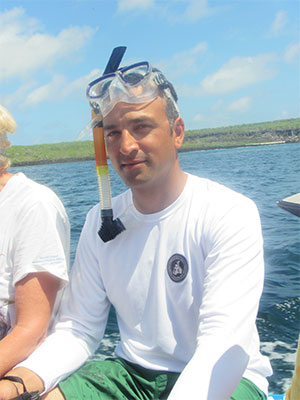
Second, experience isn’t required; as long as you are comfortable being in the water, you can use a life jacket if you’d like and still enjoy. Each excursion is escorted by our Galapagos National Park guide in the water, and a member of our vessel crew travels alongside us in a Zodiac at an appropriate distance keeping an eye out. If you’ve experienced your fill, you can board the Zodiac and be conveyed back to our vessel.
Third, each excursion is a chance to get progressively more comfortable with the experience and to gradually discover ever more diversity of marine environments. From flat, white-sand bottomed bays, to underwater cliff-sides, to boulder-strewn rocky bottoms, each place looks different and you see ever more as your eyes get progressively attuned to the more common and less common wildlife. And with several opportunities to snorkel during our week-long expedition, you will feel like a veteran by the time the trip has come to a close!
Below, I’d like to feature five interesting things you can watch for during your week:
1) The Sea Turtles
Of the several species of sea turtle in the world, the Green Sea Turtle is one we have the best chance of encountering in the Galapagos. Maintaining a respectful distance, it is remarkable to see how quickly they propel themselves through the water. I videotaped this in November 2014 while snorkelling in the shallows by Floreana Island in the south-central part of the archipelago:
A Green Sea Turtle cruising close to the water’s surface
While seeing one while snorkelling is a sporadic event, it’s a possibility to prepare for as it is simply exhilarating to find oneself swimming alongside one!
2) The Sea Stars
There are over 30 species of what we might loosely can “starfish” or “sea stars” in the Galapagos, and these are a delight to discover, especially in rockier environments, where they may live on the sea floor or cling to vertical rock faces such as those of sea cliffs. They vary in size, thickness of arms and number of arms too -not all of them have 5 arms! A favourite of many inevitably becomes the Chocolate Chip Sea Star, whose name is beyond appropriate as the well-spaced and -shaped dark markings really do recall a chocolate chip cookie! This species is also relatively conspicuous compared to some of the darker sea stars. We always challenge ourselves to see who will spot the first one of the trip!
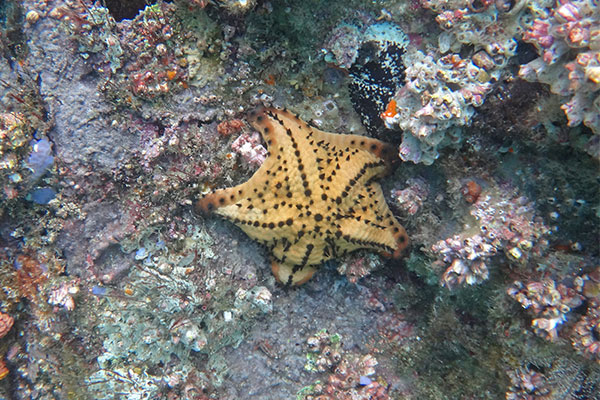
A typical view of a Chocolate Chip Sea Star
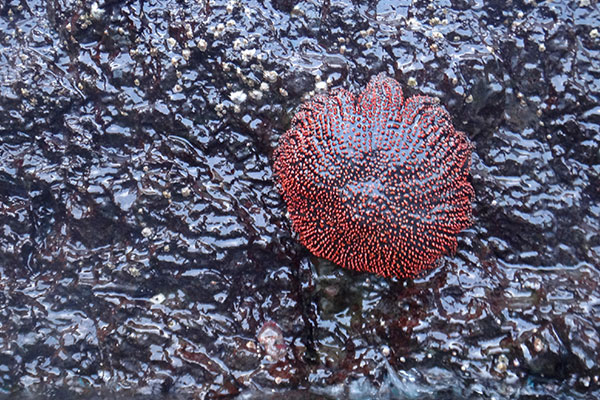
I found this Red Sun Star (Heliaster cummingi) clinging to a cliff face right
at the waterline on Kicker Rock, a favourite snorkelling spot just off San Cristobal
Island in the east. Don’t you think it has a great name?
3) The Galapagos Sea Lion (and possibly its cousin!)
We see this species on several occasions during any expedition, notably at landings where several females may congregate at traditional pupping sites and “beach master” males guard them against incursions by other males. We usually see them while snorkelling as well! Here, they gain a most graceful aspect as they slice through thewater, and they are playful as well. If you pretend to pursue one, it will swim away, then may return to provoke another chase, until it become apparent that a human (especially in snorkelling gear) could not possibly approach anything near a sea lion’s speed and the play chase is off.
Galapagos Sea Lions are active at day time when we snorkel. With some luck, we may encounter its less widespread and big-eyed nocturnal cousin, the Galapagos Fur Seal, which spends the daytime snoozing on land or sleeping underwater, occasionally popping up for air. I was lucky to encounter a Galapagos Sea Lion and a Galapagos Fur Seal together at the very same time!
Galapagos Sea Lions are active at day time when we snorkel. With some luck, we may encounter its less widespread and big-eyed nocturnal cousin, the Galapagos Fur Seal, which spends the daytime snoozing on land or sleeping underwater, occasionally popping up for air. I was lucky to encounter a Galapagos Sea Lion and a Galapagos Fur Seal together at the very same time!
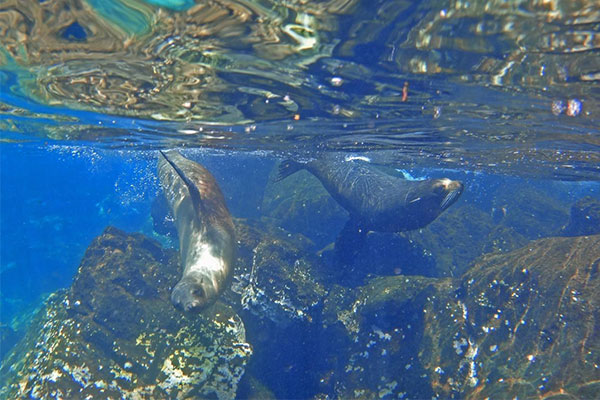
The Galapagos Sea Lion (left) popped beside its cousin, the thicker-furred
Galapagos Fur Seal (right) as I snorkelled beside North Seymour Island.
4) The Fish!
It’s probably not surprising I would mention fish, and there are many of them, including a number of endemic species -those found no where else. It is work to learn and remember their names but one becomes familiar with the appearance and names of the more common ones quickly, so that spotting less common ones becomes a fun challenge to spot and identify!
The Yellowtail Surgeonfish is among the most common
species and conspicuous as it is social!
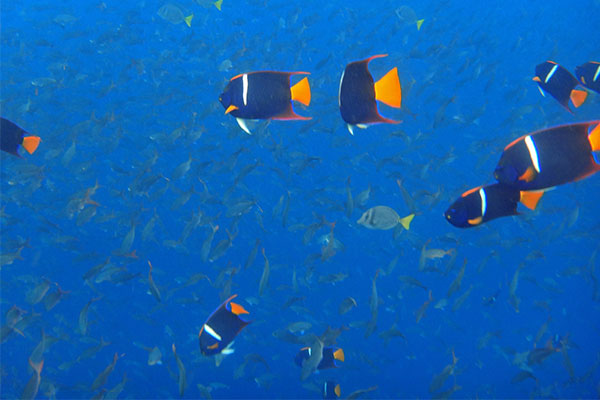
The King Angelfish is large and dazzling. I saw these off Floreana Island in deeper water.
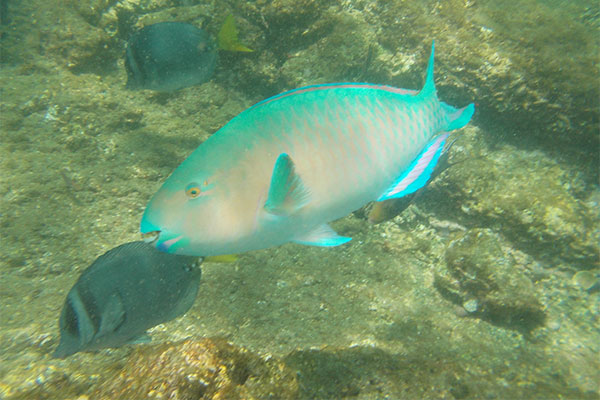
Photo credit: Pete Read
Parrotfish are solitary and are beautifully coloured. They are equipped with a hard beak that allows them to eat anything that yields to them. Mostly they feed on live coral.
5) The Galapagos Penguin
The world’s most northerly penguin and the only penguin to breed in the Northern Hemisphere, numbers of this endangered species are concentrated in the northwestern corner of the archipelago where the water tends to be cooler and more productive. One of these passing by us while snorkelling is a treat as it darts by at impressive speed! During my last trip, we had perhaps 10 of them swim right by us. That was just a half-hour after we had sighted some of them roosting quietly on a nearby volcanic shoreline.
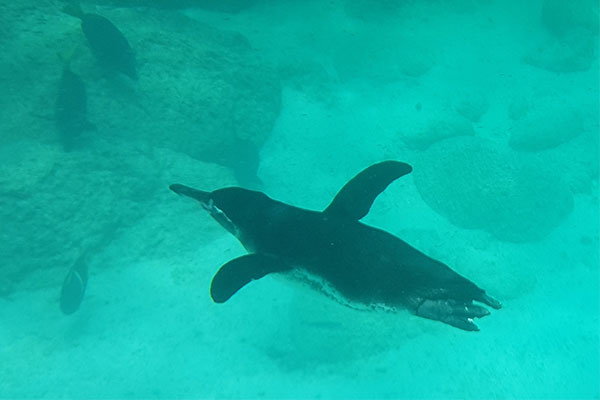
Our traveller Drew M. captured a picture of a penguin
darting by on one our expeditions
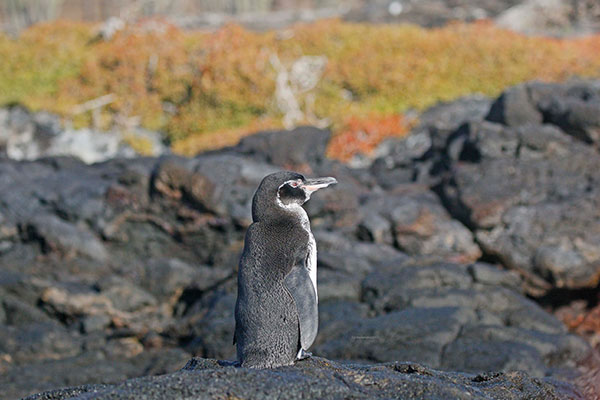
Galapagos Penguin on land as we usually see them
With the great location, expert guidance, and variety, our snorkelling forays in the Galapagos are a huge value-added experience. You will have a chance to see the signature wildlife on land, and then get to appreciate the underwater world during the intervals.


